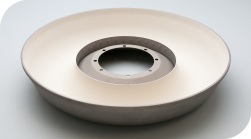Thermal Spray Coatings
Thermal Spray Processes:
- Plasma Spray
-
Plasma Spray is one of the more common methods of applying coatings,
because of its versatility and range of surface functionality. Plasma Spraying
provides coatings that are generally non-porous, dense, strong and clean.
Plasma Spray is basically the spraying of molten or heat softened material
onto a surface to provide a coating. Material in the form of powder is
injected into a very high temperature flame, where it is rapidly and
accelerated to high velocity. The hot material impacts on the substrate
surface and rapidly cools forming a coating. Plasma Spray is ideal for
large or small parts, where dimensional restoration, wear resistance or
thermal protection is required.
- Abradable Thermal Spray Coatings
-
Abradable coatings are designed to preferentially abrade when contact is made with a mating part.
Thermal spray abradable coatings have low structural integrity so they are readily abrade when they come into contact with a moving surface with higher structural integrity.
These coatings are designed not to damage the mating surface.
There are a number of different abradable coating types, to cater to different operating temperatures, corrosive environments and mating materials.
One example of abradable coating use is in gas path clearance control in gas turbine engines.
- Combustion Spray (Flame Spraying)
-
Utilizing a combination of oxygen and acetylene, the process relies on the chemical reaction between the oxygen and a fuel of combustion to produce a heat source. The feed stock material is fed into the flame in the form of a wire and compressed air is then used to atomize the molten material and accelerate the particles onto the substrate.
The combustion powder process uses a similar technique, except that the feedstock material is in powder form. The Flame Spray process is typically used in applying bond coat materials or materials that offer corrosion resistance.
- Twin Wire Arc Electric Spray
-
This form of thermal spraying uses wire material as a feedstock. An electric arc is used to provide the heat source by utilizing two current carrying wires. As the wires are fed towards each other, the electric current short circuits between the wires. The high temperature caused by the short circuit causes the tips of the wire to melt and once molten, compressed air or inert gas is used to atomize and accelerate the feed material towards the substrate.
One of the advantages of this system is that coatings may be applied without high substrate temperatures, thereby avoiding distortion to the substrate material. High spray rates and efficiency make it a good tool for spraying large surface areas. In addition, this process allows the safe application of thick coatings, much thicker than plasma coatings.
This process is often used to apply corrosion resistant coating on large components, and for dimensional restoration where a thick, coating build up is required.
- HVOF (High Velocity Oxy/Fuel)
-
HVOF is a thermal spray system utilizing the combustion of gases, such as hydrogen, or a liquid fuel such as kerosene. Fuel and oxygen mix and atomize within the combustion area under conditions that monitor the correct combustion mode and pressure. The process creates a very high velocity which is used to propel the particles at supersonic speeds before impact to the substrate. One of the basic rules of spraying is that a high combustion pressure equals high gas velocity, high particle velocity.
One of the key benefits of this systems high velocity is the extremely high coating density and low oxide content. The low oxide content is partly due to the speed of the particles spending less time within the heat source, and partly due to lower flame temperatures when compared with alternative processes.
As well as producing excellent bond strength, some HVOF coatings can be sprayed very thick due to the exceptionally high velocities producing coatings in compression instead of tension.
- HVAS (High Velocity Arc Spray)
-
HVAS is a Twin Wire Arc application that is applied at high velocities to produce a denser and less porous coating structure than typical twin wire arc applications.

Coatings:
- Metallics
- Alloys
- Carbides
- Ceramics
- Abradables
- Plastics
- Polymers
- Environmental Barrier Coatings
- Specialty Blends - Cermets
